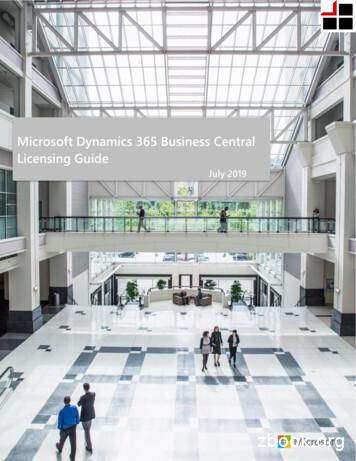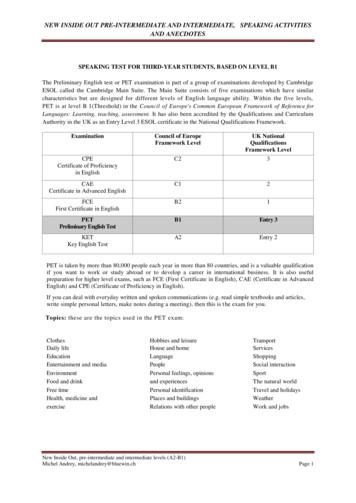ME 464 Intermediate Dynamics Spring 2020
ME 464 – Intermediate Dynamics – Spring 2020Instructor:Dr. Firas A. Khasawneh khasawn3@egr.msu.eduOffice: 2503 EB, (517) 432-0471Dr. Recktenwald, gdr@egr.msu.eduOffice: 2328b Engineering Building, (517) 432-3658,Lectures:MWF from 3:00-3:50 in 1230 Engineering BuildingOffice hours: Dr. Khasawneh: (End on 2/28/2020)M 9:00AM-10:00AM, F 11:00AM-noon, or by appointmentDr. Recktenwald: TBD (Begin on 3/9/2020)Website:Desire-to-learn (D2L.msu.edu) - Check for announcements, updates, & solutions.Textbook(s): *Introductory Text: Engineering Mechanics: Dynamics, by R.C. Hibbeler Pearson*Intermediate Text:@Applied Dynamics, by F. C. Moon*requiredOther excellent texts: (‡ on reserve at the Library) (@ e-text @ lib.msu.edu)Analytical Dynamics, by Haim Baruh‡Vector Mechanics for Engineers-Dynamics, by Beer & JohnstonApplied Dynamics, by Haim Baruh‡Principles of Dynamics AND @ Advanced Dynamics, by GreenwoodVibrations, by Thomson and DahlehObjectives: Upon completing this course you should be able to:(1) Identify the forces acting on a system by the environment and draw a correct freebody diagram.(2) Apply Newton/Euler and/or Lagrangian methods to derive the equations of motionfor the system.(3) Analyze the equations and obtain solutions analytically when possible.(4) Find solutions by numerical methods.(5) Study the results and explain the implications for stability, dynamic loads, and otherdesign issues.(6) Make reasonable assumptions to simplify a mechanical system to the degree that itcan be modeled by the principles of dynamics.Office Hours: I am delighted to meet with students during office hours to clarify course issuesand concepts. It is expected that students will give forethought to their questionsprior to attending office hours. Don’t be embarrassed to visit with a “simple” or“easy” question, often the answers to simple questions provide the most insight.1/4/2020
Examinations: All exams are closed-book, in-class exams. You may bring a single 3x5 notecardwith formula and a calculator*.Exam ScheduleMake-up exams will be givenonly in the case of documented Exam 1: Wednesday, Jan. 29th during classemergencies. Early exams will Exam 2: Wednesday, Feb. 26th during classnot be given.Exam 3: Wednesday, Apr. 1st during classFinal: Wednesday, April 29th 5:45-7:45 pmHomework: The importance of diligence ondynamics homework cannot bestressed enough!!! Homework will be assigned weekly and collected in class onFridays. Solutions should be written clearly and methodically.Late homework: Late homework may be turned in, but will be penalized at a dailyrate of 10%. Late homework will be assigned an effort grade of 30% after solutionshave been posted. Solutions to all problems will be posted on D2L.Collaboration: Student collaboration on the homework is encouraged, but you mustwrite up and submit your own solutions. Students are expected to fully work out allproblems as they are an integral part of the learning experience.Mini-Project / Mega-problem: Some homework assignments will have a problem that requiresa more in-depth analysis. These projects will require you to use Matlab orMathematica.Exam Corrections: After exams 1, 2, & 3 you will correct the problem with the lowest score.Corrected solutions should be clearly written; like examples in the textbook. Theexam corrections will count towards your homework score.Grading:Your course grade is based on your in class grade total percentage. Your classgrade will be based on 5 equally weighted components: Exam 1, Exam 2, Exam 3,Final, and Homework/Projects. I reserve the right to increase the weight of the finalexam if it is in your best interests.class total percentcourse grade 90% 85% 80% 75% 70% 65% 60% 60%4.03.53.02.52.01.51.00Calculators: A calculator may be used on the exams, however calculators man NOT be shared.Only independent, non-networked calculators may be used on exams. No phones,tablets or computers may be used or present during the exams. Students shouldhave an extra set of batteries for their calculator in their bag; extra time will not beprovided if there is a calculator failure.Electronics: Cellphones and computers can be distracting to yourself and other students. Recentresearch has shown the use of cellphones in class can lead to significantly lowercourse scores. Unless you receive prior permission to use them, they should remainsilently in your bag.Class Attendance: Absence from class can cause serious confusion; students are expected toattend lectures which are the standard forum for class communication. Students areexpected to prepare for class by reading the text material prior to class and1/4/2020
examining the sample problems in the text. Class absence is not an excuse forbeing unaware of course announcements or course materials. Lecture notes shouldbe obtained from a peer in the class, the instructor is not responsible for providinglecture notes due to a student's absence.International Students: If English is not your first language you may find some of the terminologyin this course confusing. Please speak up if something is not clear. Raise yourhand for clarification during exams.Communication: Email and other communication should comply with professional standards ofcorporate best practice. Use informative subject lines like “ME 464 question: HW 2prob. 3”.Accommodations for Students with Disabilities: Michigan State University is committed toproviding equal opportunity for participation in all programs, services and activities.Requests for accommodations by persons with disabilities may be made bycontacting the Resource Center for Persons with Disabilities at 517-884-RCPD oron the web at rcpd.msu.edu. Once your eligibility for an accommodation has beendetermined, you will be issued a Verified Individual Services Accommodation("VISA") form. Please present this form to me at the start of the term and/or twoweeks prior to the accommodation date (test, project, etc.). Requests received afterthis date may not be honored.Ethics:Engineers must adhere to a rigorous code of professional ethics. Unethical conductin ME464 will result in the maximum disciplinary action permitted by Michigan StateUniversity. Unethical conduct in this class includes, but is not limited to, cheating onexams and quizzes, and supplying information to others on exams and quizzes.Students bear due responsibility for ensuring the security of their examination work.There is a professional duty to report unethical conduct by others, including peers.If you have any questions, your instructor is available to discuss issues ofprofessional expectations and ethics.The Associate Students of Michigan State University (ASMSU) proudly launchedthe following Spartan Code of Honor academic pledge.As a Spartan, I will strive to uphold values of the highest ethical standard. Iwill practice honesty in my work, foster honesty in my peers, and take pridein knowing that honor is worth more than grades. I will carry these valuesbeyond my time as a student at Michigan State University, continuing theendeavor to build personal integrity in all that I do.” – Spartan pledgeSoftware:Students should have access to Matlab and know how to use it. Matlab is availablein all computer labs and is free to students through the bookstore.Matlab Resources: MATLAB Onramp (free) on the MATLAB Academy site. MATLAB and Simulink Tutorials (free): Get started with the basics of MATLAB andSimulink.1/4/2020
Getting Started with MATLAB (free): Documentation to introduce students toMATLAB. MATLAB Code Examples (free): Basic examples. MATLAB Examples (free): More MATLAB examples for a variety of applications. Cody (free): A social game intended to refresh and build students’ MATLAB skills. Introduction to Programming with MATLAB : MOOC offered on the Courseraplatform. This introductory programming class uses MATLAB as the language forimplementation.1/4/2020
3-DLagrange3-D Rigid BodiesNewton EulerVirtual Work &Lagranges equationsMomentum &ImpactWork &EnergyKineticsKinematics &Frames of Ref.DaySpring 2020 – Intermediate Dynamics: Tentative 24/244/29MWFMWFMWFMWFMWFMWFWIntroductionCoordinate systemsCoordinate systemsTranslating coordinatesRotating coordinatesEquations of motion (EOM)MLK Day – No classEOM: The spherical pendulumEOM: Four-bar linkage & pistonThe work energy equationExam 1PowerEquations of motionMomentum (Linear & Angular)Fluid FlowRockets (variable mass)Kepler’s Laws (I, II, & III)Orbital MotionImpact (Eccentric)Projectile motionMoment of inertia tensorReviewExam 2Review of materialSpring Break – No classVirtual displacementsGeneralized Coordinates12:1-8*1/31* - End of tuition refund periodChapter 12.2HW0112:1016:816.5&7, 17:1-33.4HW02Handout17:4-5HW03Ch18 (ref 14)14.422.215.5-7,19:1-315.815.913.7HW042.4 (pg 59)2.4HW057:1-2HW0615.4, 19.421.12.5HW07HW082.34.1, 6.34.2-3, 5.4,6.42.6, 4.5LagrangianConstraintsExternal ForcesExamplesVirtual PowerHamilton’s PrincipleThe Foucault pendulumReviewExam 3Matrix rThe spinning topThe GyroLagrange in 3-DLagrange in 3-DReview for final examDesign Day – No classFinal Exam – 5:45pm-7:45pmHomeworkHW09HW102.7, 4.4, 5.54.6Ch 20Handout21.2&4HW113.6-8, 5.1-23.2, 5.3HW12HW1321.5-621.35.4HW14HW15**2/26 – End of drop period.This is a tentative schedule. Additional readings are available upon request.1/4/2020
Analytical Dynamics, by Haim Baruh ‡Vector Mechanics for Engineers-Dynamics, by Beer & Johnston Applied Dynamics, by Haim Baruh @‡Principles of Dynamics AND Advanced Dynamics, by Greenwood Vibrations, by Thomson and Dahleh Objectives: Upon completing this course you should be able
Business Ready Enhancement Plan for Microsoft Dynamics Customer FAQ Updated January 2011 The Business Ready Enhancement Plan for Microsoft Dynamics is a maintenance plan available to customers of Microsoft Dynamics AX, Microsoft C5, Microsoft Dynamics CRM, Microsoft Dynamics GP, Microsoft Dynamics NAV, Microsoft Dynamics SL, Microsoft Dynamics POS, and Microsoft Dynamics RMS, and
Microsoft Dynamics 365 for Operations on-premises, Microsoft Dynamics NAV, Microsoft Dynamics GP, Microsoft Dynamics SL, Microsoft Dynamics AX 2012 or prior versions, or Microsoft Dynamics CRM 2016 or prior versions. This guide is not intended to influence the choice of Microsoft Dynamics products and services or provide technical specification.
This guide is designed to improve your understanding of how to license Microsoft Dynamics 365, Business edition. This document does not apply to Dynamics 365, Enterprise edition, Microsoft Dynamics NAV, Microsoft Dynamics GP, Microsoft Dynamics SL, Microsoft Dynamics AX 2012, or Microsoft Dynamics CRM 2016 or any other prior version.
Microsoft Dynamics Guide Dynamics GP vs. Dynamics 365 (NAV) vs. Dynamics SL . Dynamics 365 BC -1 Premium User 100/month/user (Subscription) 2000 (On-Premise) . Solomon's application became Dynamics SL. Dynamics SL is geared first and foremost for project-based businesses. This makes SL the
Microsoft Dynamics 365 for Operations on-premises, Microsoft Dynamics NAV, Microsoft Dynamics GP, Microsoft Dynamics SL, Microsoft Dynamics AX 2012 or prior versions, or Microsoft Dynamics CRM 2016 or prior versions. This guide is not intended to influence the choice of Microsoft Dynamics products and services or provide technical specification.
NEW INSIDE OUT PRE-INTERMEDIATE AND INTERMEDIATE, SPEAKING ACTIVITIES AND ANECDOTES New Inside Out, pre-intermediate and intermediate levels (A2-B1) Michel Andrey, michelandrey@bluewin.ch Page 2 Timing: 10-12 minutes per pair of candidates. Candidates are assessed on their performance throughout the test. There are a total of 25 marks in Paper 3,
The series takes students through key aspects of English grammar from elementary to upper intermediate levels. Level 1 – Elementary to Pre-intermediate A1 to A2 (KET) Level 2 – Low Intermediate to Intermediate A2 to B1 (PET) Level 3 – Intermediate to Upper Intermediate B1 to B2 (FCE) Key features Real Language in natural situations
The SRD is the ultimate axial pile capacity that is experienced during the dynamic conditions of pile driving. Predictions of the SRD are usually calculated by modifying the calculation for the ultimate static axial pile capacity in compression. API RP 2A and ISO 19002 refer to several methods proposed in the literature.























